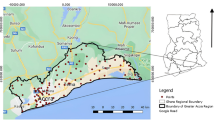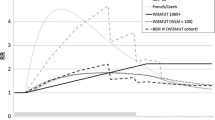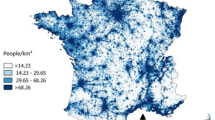Abstract
Indoor radon (Rn) is believed an important risk to human health. Therefore Rn monitoring programs have been initiated in many countries. Currently the European Commission is discussing Basic Safety Standards for protection against ionizing radiation, requiring inter alia to establish radon action plans and to identify so-called radon prone areas. Risk is commonly defined as probability that indoor Rn concentration exceeds a threshold.
Access provided by Autonomous University of Puebla. Download conference paper PDF
Similar content being viewed by others
Keywords
1 Introduction
Indoor radon (Rn) is believed an important risk to human health. Therefore Rn monitoring programs have been initiated in many countries. Currently the European Commission is discussing Basic Safety Standards for protection against ionizing radiation, requiring inter alia to establish radon action plans and to identify so-called radon prone areas. Risk is commonly defined as probability that indoor Rn concentration exceeds a threshold.
In Germany datasets of Rn concentration in soil air, of soil permeability and of indoor Rn concentrations exist linked to geology. However indoor Rn has not been surveyed representatively, thus the data cannot be used directly for risk assessment. Instead it was decided to use geogenic radon as predictor in a probabilistic “transfer” model soil-indoor Rn. Indoor data shall be used to “calibrate” the model. Known geogenic Rn shall allow estimating the mean Rn risk in rooms and buildings with given physical characteristic as regards Rn infiltration and accumulation.
2 Materials and Methods
Data are taken from the German GIS-based Rn database which includes indoor Rn concentrations together with information on relevant house-related control parameters (floor level, year of construction, etc.), soil radon, soil permeability and geology. This study restricts to indoor Rn values of dwellings in ground floor levels of houses with basement.
Radon potential is defined RP := \(\mathrm{{C}}_\mathrm{{S}}\)/(\(-_{10}\)log(k)\(-10\)), based on a concept suggested by [1]; \(\mathrm{{C}}_\mathrm{{S}}\) = Rn concentration in soil air (kBq/m\(^{3})\), k = permeability (m\(^{2})\). For geological classification a simplified geological map is used (after [2]).
Local probability that indoor Rn concentration C exceeds a threshold is derived from geogenic Rn, quantified by the RP. As first step, a map of the RP is generated; Second, a “transfer” model RP(x)\(\rightarrow \)prob[C(x)\(>\)c] is established. Here the fact that RP and C are not observed at the same locations poses a particular challenge. For the transfer model a Gumbel copula model of the bivariate joint distribution of RP and C is estimated.
3 Results
3.1 The predictor Map
Geology is considered as a categorical predictor. This was done as in [3] as a simplified regression kriging scheme, but with Gaussian sequential simulation instead, in order to recover local conditional distributions. The raw values \(\mathrm{{RP}}_\mathrm{i}\) are transformed into Y\(_\mathrm{i}\) := ln(RP\(_\mathrm{i}\) / RP\(_\mathrm{G})\), with RP\(_\mathrm{G}\) the mean RP over geological class G. \(\mathrm{{Y}}_\mathrm{i}\) is subjected to spatial modelling, which results in realizations of the simulation algorithm. Each is back-transformed which yields the wanted conditional distributions \(\mathrm{{F}}_\mathrm{{RP}}\)(x)(rp). The resulting map is shown in Fig. 1. (Empty cells: no geological unit covered by observations could be assigned to the centre of the cell.)
This method is simple but has drawbacks: (1) \(\mathrm{{RP}}_\mathrm{G}\) are simple means which may be biased because usually the observations are not uniformly (e.g. randomly) distributed within each geological class, but may be clustered; (2) The variogram is estimated for the variable Y, although no continuity of Y(x) or RP(x) across geological borders can be anticipated.
3.2 Model of Bivariate Distribution
We want to estimate the local exceedance probability \(\mathrm {p(x)}=\mathrm {prob}\)[C(x)\(\,>\mathrm{{c}}{\vert }\mathrm{{RP(x)}}=\mathrm{{rp}}]\) which can be derived from the bivariate joint distribution \(\mathrm{{F}}_\mathrm{{C,RP}}\). Introducing a copula \(\Psi _\mathrm{{C,RP}}\), we find \(1-\)p = \(\partial \Psi _\mathrm{{C,RP}}\)(F\(_\mathrm{{C}}\)(c),F\(_\mathrm{{RP}}\)(rp))/\(\partial \)F\(_\mathrm{{RP}}\)(rp). The marginals F\(_\mathrm{C}\) and F\(_\mathrm{RP}\) were determined by spatial de-clustering of the data.
As copula model a Gumbel type is chosen for several reasons. (1) It seems appropriate to strongly right-skew data, as typical for Rn related quantities. (2) Its parameter \(\upvartheta \) is related to Kendall \(\uptau \) by \(\uptau \) = 1\(-\)1/\(\upvartheta \), and thus easy to estimate from data. (3) It allows upper tail dependency, other than binormal copulae, which do not allow conditional prediction of high extremes. Alternatives will be explored in the future.
Inserting the Gumbel copula leads to an analytic expression of p in dependence of \(\upvartheta \) and the marginals F\(_\mathrm{{RP}}\)(rp) and F\(_\mathrm{{C}}\)(c) which can be evaluated once \(\upvartheta \) is known.
3.3 Lagged Correlation
The lagged Kendall correlation \(\uptau \)(h) for lag h is computed for subsets of the data allowing estimation of uncertainty. The wanted value for \(\mathrm {h}=0\) is estimated by extrapolation of \(\uptau \)(h) towards \(\mathrm {h}=0\). (The method corresponds to estimating a nugget from an empirical variogram.) For the Rn data we find \(\uptau (0)=0.16\) which is a rather weak correlation; this reflects the fact the indoor Rn (C) is controlled also by other factors than soil Rn (RP). The value was confirmed by correlating a collocated dataset generated by estimating (ordinary kriging) RP at the locations of C.
3.4 The Rn Risk Map
The local (at unsampled \(\mathrm {x}^*\), a grid node) expectation of the wanted exceedance probability p is calculated as
where W\(_\mathrm{{RP}\,(\mathrm {x}^*)}\) denotes the local conditional distribution of predictor RP (result of Sect. 3.1), rp(\(\upomega \), x\(^*\)) its \(\upomega \)-th realization at x\(^*\) and \(\Omega \) the sample space of the simulation, whose realizations are indexed by \(\upomega \) and p(rp) the exceedance probability as function of the RP (from the model Sect. 3.2). In practice this is simply the mean over realizations. The resulting map is shown in Fig. 2. Similarly the local expectation of C at x\(^*\) can be calculated, involving a second integration over F(\(\mathrm{{c}}{\vert }\mathrm{{RP}}(\mathrm {x}^*)=\mathrm{rp}(\upomega \),x\(^*\))), with \(\mathrm {F}=1-\)p, to be performed numerically.
Since the transform RP \(\rightarrow \) p(RP) is not linear, \(\mathrm{{E}}_\mathrm{{spat}}[\mathrm {prob}(\mathrm {C}(\mathrm {x}^*)>\mathrm {c}){\vert }\mathrm{{RP}}(\mathrm {x}^*)] \ne \mathrm {p}(\mathrm {C}(\mathrm {x}^*)>\mathrm{{c}}{\vert }\mathrm{{E}}_\mathrm{{spat}}(\mathrm {RP})(\mathrm {x})]\) which would be easier to calculate, but contains a bias.
4 Discussion and Conclusions
The transfer model is global in that the same model for the joint distribution of indoor and soil Rn is assumed over the domain (the territory of Germany). This may be considered an analogue to second-order stationarity in RF theory. However factors which control indoor Rn which have a regional trend may invalidate the strict assumption and render the proposed solution an approximation.
Validation of the probabilities p(x) is not easy because only relatively few cells with sufficient data are available. For those cells with higher mean RP (i.e. stronger geogenic control) the empirical probabilities lie well within a 95 % confidence interval (also recovered from the realizations, as above) of the estimated p(x).
The results turn out sensitive against choice of the marginal distributions \(\mathrm{{F}}_\mathrm{{RP}}\) and \(\mathrm{{F}}_\mathrm{{C}}\) resulting from data de-clustering while sensitivity against the Gumbel \(\vartheta \) is relatively low.
“Complete” bivariate geostatistical modelling, e.g. by cokriging or co-simulation, has not been performed because (1) a relatively simple (in comparison) transfer model geogenic \(\rightarrow \) indoor Rn was requested, and (2) because co-variography has been considered prohibitive. Simplifications such as the “Markov M1” assumption suffer from non-collocated data.
Among issues to be addressed in future are inclusion of further predictors such as geochemical quantities, extension to other categories of indoor Rn data and higher spatial resolution.
References
Neznal, M., Neznal, M., Matolin, M., Barnet, I., & Miksova, J. (2004). The new method for assessing the radon risk of building sites. Czech Geol. Survey Special Papers, 16, Czech Geol. Survey, Prague, p. 47. Retrieved March 29, 2013 from http://www.radon-vos.cz/pdf/metodika.pdf
Kemski, J., Siehl, A., Stegemann, R., & Valdivia-Manchego, M. (2001). Mapping the geogenic radon potential in Germany. The Science of the Total Environment, 272(1–3), 217–230.
Bossew, P., Dubois, G., & Tollefsen, T. (2008). Investigations on indoor radon in Austria, part 2: Geological classes as categorical external drift for spatial modelling of the radon potential. Journal of Environmental Radioactivity, 99(1), 81–97.
Author information
Authors and Affiliations
Corresponding author
Editor information
Editors and Affiliations
Rights and permissions
Copyright information
© 2014 Springer-Verlag Berlin Heidelberg
About this paper
Cite this paper
Bossew, P. (2014). A Radon Risk Map of Germany Based on the Geogenic Radon Potential. In: Pardo-Igúzquiza, E., Guardiola-Albert, C., Heredia, J., Moreno-Merino, L., Durán, J., Vargas-Guzmán, J. (eds) Mathematics of Planet Earth. Lecture Notes in Earth System Sciences. Springer, Berlin, Heidelberg. https://doi.org/10.1007/978-3-642-32408-6_115
Download citation
DOI: https://doi.org/10.1007/978-3-642-32408-6_115
Published:
Publisher Name: Springer, Berlin, Heidelberg
Print ISBN: 978-3-642-32407-9
Online ISBN: 978-3-642-32408-6
eBook Packages: Earth and Environmental ScienceEarth and Environmental Science (R0)






